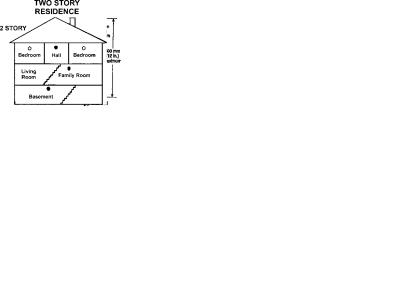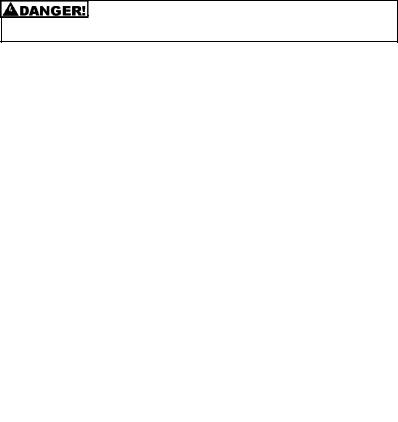Universal Security Instruments USI-5204 User Manual

Visit Us on the Web! www.SmokeAlarms.com
MODEL USI-5204 |
USI-5204 |
(Part #USI-5204HA)
COMMERCIAL RESIDENTIAL (UTHA)
SMOKE & FIRE ALARM WITH SILENCE CONTROL
READ ALL INSTRUCTIONS
The smoke alarm has a recommended service life of at least 10 years under normal conditions. The smoke alarm uses an extremely small amount of a radioactive element in the ionization chamber. Do not tamper with radioactive sealed source or try to repair the smoke alarm yourself. Refer to instructions for repairs.
SMOKE ALARM LIMITATIONS AND FUNCTIONS
•THERE ARE TWO BASIC SMOKE ALARM TYPES - IONIZATION AND PHOTOELECTRIC. Ionization smoke alarms are your best overall choice for reliability and fast response time, since they quickly sense small "invisible" smoke particles and will also sense larger "visible" smoke particles. Photoelectric smoke alarms may respond more quickly in certain types of fires, for example - slow smoldering fires with large "visible" smoke particles. ALL TYPES OF SMOKE ALARMS HAVE LIMITATIONS. NO TYPE OF SMOKE ALARM CAN SENSE EVERY KIND OF FIRE OR SMOKE EVERY TIME.
•WARNING - SMOKEALARMS WILLNOTWORK DURINGALOSS OF POWER. SINCEASMOKE ALARM WILL NOT WORK WITHOUT POWER, having an alarm(s) that works from two completely different power sources, such as anAC direct wire with battery backup smoke alarm, can give you an extra measure of protection in case of an AC power failure or a dead battery.
•USING A SMOKE ALARM IN A SMOKY AREA LIKE A KITCHEN, OR IN A HIGH HUMIDITY AREA NEAR A SHOWER, CAN CAUSE FALSE ALARMS. DO NOT TURN OFF THE AC POWER TO QUIET THE ALARM. A SMOKE ALARM WILL NOT HELP PROTECT YOU IF IT IS NOT POWERED. Properly locate your alarm to avoid nuisance alarms.
•ASMOKEALARMMAYNOTALWAYSWARNYOUABOUTFIRESCAUSEDBYCARELESSNESS AND SAFETY HAZARDS LIKE SMOKING IN BED, VIOLENT EXPLOSIONS, ESCAPING GAS, IMPROPER STORAGE OF FLAMMABLE MATERIALS, OVERLOADED ELECTRICALCIRCUITS, CHILDREN PLAYING WITH MATCHES, NATURALCAUSES SUCHAS LIGHTNING, ORARSON. FIRE PREVENTION IS YOUR BEST SAFEGUARD.
•INSTALLING SMOKE ALARMS MAY MAKE YOU ELIGIBLE FOR LOWER INSURANCE RATES, but SMOKE ALARMS ARE NOT A SUBSTITUTE FOR INSURANCE. Homeowners and renters alike should continue to insure their lives and properties.
•SMOKEALARMS CANNOT WORK WITHOUT POWER. Battery operated units cannot work if the batteries are missing, disconnected or dead, if the wrong type of batteries are used or if the batteries are not installed correctly. AC (only) powered units cannot work if the AC power is cut off for any reason. If you are concerned about the limitations of battery or AC power, install both types of units.
•SMOKE ALARMS CANNOT DETECT FIRES IF THE SMOKE DOES NOT REACH THEM. Smoke from fires may not reach the sensing chamber and set off the alarm. One unit should be installed inside each bedroom or sleeping area.
•SMOKE ALARMS MAY NOT DETECT FIRE ON ANOTHER FLOOR OR AREA OF THE HOME. Recommended minimum protection is at least one unit in every sleeping area and every bedroom on every level of your home. Interconnected units may provide earlier warning than stand-alone units since all units alarm when one detects smoke.
•SMOKE ALARMS MAY NOT BE HEARD. The alarm horn in this unit meets or exceeds current standards, but it may not be heard if: (1) the unit is located outside a closed or partially closed door; (2) residents recently consumed alcohol or drugs; (3) the alarm is drowned out by noise from stereos, TV's, air conditioners or other appliances or (4) if residents are hearing impaired or sound sleepers.
•SMOKE ALARMS ARE NOT FOOLPROOF. You must test the unit weekly to ensure your continued protection. Smoke alarms cannot prevent or extinguish fires.
•SMOKE ALARMS HAVE A LIMITED LIFE. The unit should be replaced immediately if it is not operating properly. You should always replace a smoke alarm after 10 years.
•SMOKE ALARMS ARE NOT TO BE USED WITH DETECTOR GUARDS UNLESS THE COMBINATION HAS BEEN EVALUATED AND FOUND SUITABLE FOR THAT PURPOSE.
•CURRENT STUDIES HAVE SHOWN SMOKE ALARMS MAY NOTAWAKEN ALL SLEEPING INDIVIDUALS AND THAT IT IS THE RESPONSIBILITY OF INDIVIDUALS IN THE HOUSEHOLD WHO ARE CAPABLE OF ASSISTING OTHERS TO PROVIDE ASSISTANCE TO THOSE WHO MAY NOT BE AWAKENED BY THE ALARM SOUND OR TO THOSE WHO MAY BE INCAPABLE OF SAFELY EVACUATING THE AREA UNASSISTED.

RECOMMENDED LOCATION OF ALARMS
•Locate the first smoke alarm in the immediate area of the bedrooms. Try to protect the escape route as the bedrooms are usually farthest from an exit. If more than one sleeping area exists, locate additional smoke alarms in each sleeping area. If a hall is more than 40 feet (12 meters) long, install a smoke alarm at each end.
•Locate additional smoke alarms to protect any stairway as stairways act like chimneys for smoke and heat.
•Locate at least one smoke alarm on every floor level.
•Locate a smoke alarm in any area where a smoker sleeps or where electrical appliances are operated in sleeping areas.
•Smoke, heat and other combustion products rise to the ceiling and spread horizontally. Mounting the smoke alarm on the ceiling in the center of the room places it closest to all points in the room. Ceiling mounting is preferred in ordinary residential construction. However, in mobile homes, wall mounting on an inside partition is preferred to avoid the thermal barrier that may form at the ceiling.
•When mounting smoke alarm on the ceiling, locate it a minimum of 4" (10cm) from a side wall or corner (see Diagram A).
•When mounting smoke alarm on a wall, if local codes allow, use an inside wall with the top edge of the smoke alarm a minimum of 4" (10cm) and a maximum of 12" (30.5cm) below the ceiling/ wall intersections (See Diagram A).
Existing Homes:
The NFPArequires a smoke alarm on every level and outside each sleeping area in existing construction. An existing household with one level and one sleeping area is required to have one smoke alarm.
New Construction Homes and Manufactured Homes:
The NFPArequiresAC-powered, interconnected smoke alarms to be installed inside each bedroom, outside each bedroom area, and on every level of the home. They also require a minimum of two AC-powered, interconnected smoke alarms in any new construction home.
Sloped Ceilings (Peaked Ceilings):
Smoke alarms or smoke detectors mounted on a peaked ceiling shall be located within 36 in. (914 mm) horizontally of the peak, but not closer than 4 in. (102 mm) vertically to the peak.
Sloped Ceilings (Shed Ceilings):
Smoke alarms or smoke detectors mounted on a sloped ceiling having a rise greater than 1 ft. in 8 ft. (1 m in 8 m) horizontally shall be located within 36 in. (914 mm) of the high side of the ceiling, but not closer than 4 in. (102 mm) from the adjoining wall surface.
Tray-Shaped Ceilings:
Smoke Alarms or smoke detectors shall be installed on the highest portion of the ceiling or on the sloped portion of the ceiling within 12 in. (305 mm) vertically down from the highest point.
Mobile Home Installation:
For minimum protection, smoke alarms should be installed in compliance with H.U.D. Manufactured Home Construction Safety Standards, Title 24 CFR, Section 3280.208 and Section 3282. For additional protection, see Single Story Residence smoke alarm requirements/recommendations for Existing Homes and New Construction Homes.
Note: For mobile homes built before 1978, install smoke alarms on inside walls between 4” and 12” from the ceiling (older mobile homes have little or no insulation in the ceiling). This is especially important if the ceiling is unusually hot or cold.
Install a smoke alarm inside each bedroom and in the hallway outside each separate sleeping area.
Page 2

AVOID THESE LOCATIONS
•the garage – products of combustion are present when you start your automobile.
•near appliances or areas where normal combustion regularly occurs (kitchens, near furnaces, gas hot water heaters). Use smoke alarms with Silence Control for these areas.
•in areas with high humidity, like bathrooms or areas near dishwashers or washing machines. Install at least 3 feet (0.9 meters) away from these areas.
•in areas of turbulent air such as air returns or heating and cooling supply vents, smoke alarms shall not be located where airflow prevents operation of the alarms.
•in extremely dusty, dirty or insect-infested areas. Loose particles interfere with smoke alarm operation.
•in areas where temperature may fall below 400F (4.40C) or rise above 1000F (37.80C).
•closer than 1 foot (0.3m) from fluorescent lights, electrical "noise" and flickering may affect the alarm's operation.
•closer than 3 feet (0.9m) horizontal path from the tip of the blade of a ceiling suspended (paddle) fan.
•on a poorly insulated ceiling or exterior wall (mount smoke alarm on an inside wall).
THIS SMOKE ALARM WILL NOT WORK WITHOUT 120 VAC POWER AND A GOOD BATTERY PROPERLY INSTALLED. THE SMOKE ALARM SHOULD BE TESTED WHEN INSTALLED AND THEN TESTED WEEKLY AFTER THAT.
FALSE ALARMS
The smoke alarm is designed to minimize false alarms. Smoking will not normally set off the alarm unless smoke is blown directly into the smoke alarm. Combustion particles from cooking may set off the alarm if the smoke alarm is located close to the kitchen cooking surface. Large quantities of combustion particles are generated from spills or broiling.
If the smoke alarm does sound, check for fires first. If a fire is discovered, get out and call the fire department. If no fire is present, check to see if one of the reasons listed above may have caused the alarm. Use the "silence" feature if it is a false alarm.
INSTALLATION AND OPERATION
INSTALLATION INSTRUCTIONS: CAUTION!! READ CAREFULLY. CAUTION: THIS UNIT IS SEALED. THE COVER IS NOT REMOVABLE!
•A mounting plate is provided on the back of the alarm.
•Remove the mounting plate from the back of the alarm by holding the mounting plate and twisting the alarm in the direction indicated by the "TURN TO REMOVE" arrow on the side of the alarm base.
Installation of this unit must conform to the electrical codes in your area; Article 760 of the National Electrical Code, NFPA 72, 101; SBC (SBCCI); UBC (ICBO); NBC (BOCA): OTFDC (CABO), and any other local or building codes that may apply. Wiring and installation must be performed by a licensed electrician. Failure to follow these guidelines may result in injury or property damage.
This unit must be powered by a 24-hour, 120V AC 60Hz circuit. Be sure the circuit cannot be turned off by a switch, dimmer or ground fault circuit interrupter. Failure to connect this unit to a 24-hour circuit may prevent it from providing constant protection.
IMPORTANT: Do not subject this smoke alarm to megger, high voltage or high-pot tests. Remove the smoke alarm(s) before high-potting tests occur on the circuit or system. (Ref. Section 550-17, National Electric Code, 2002 Edition).
ELECTRICAL SHOCK HAZARD
Turn off power to the area where you will install this unit at the circuit breaker or fuse box before beginning installation. Failure to turn off the power before installation may result in serious electrical shock, injury or death.
TAMPER LOCKING PIN: To make your alarm somewhat tamper resistant, a locking pin has been provided (break-away part of mounting plate). Using this tamper pin will deter children and others from removing the alarm from the mounting plate. To use the tamper pin, insert it into the hole in the side of the alarm after the alarm has been installed on the mounting plate. Using long nose pliers, pull the tamper pin out of the hole. It is now possible to remove the alarm from the mounting plate.
1.Turn the alarm counterclockwise in the direction indicated by the "TURN TO REMOVE" arrow on the side of the alarm base to remove it from the mounting plate. NOTE: The alarm is sealed and the cover is not removable.
Page 3
